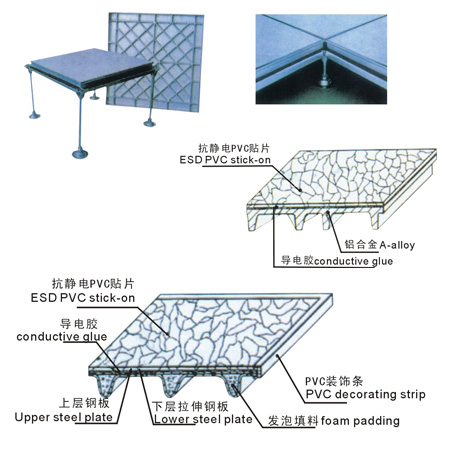

The principle of static electricity 1. Micro reasons Ac […]
The principle of static electricity
1. Micro reasons
According to the theory of atomic physics, matter is in electrical equilibrium when it is electrically neutral. Due to the contact between atoms of different substances, the gains and losses of electrons are generated, causing the substances to lose their electrical balance and generate static electricity.
Substances are composed of molecules, and molecules are composed of atoms, and the atoms have negatively charged electrons and positively charged components. Under normal conditions, the number of protons and electrons of an atom are the same, and the positive and negative balances are balanced, so it appears uncharged to the outside. However, protons are electrons that surround the nucleus. Once external force, they leave the orbit, leave the original nucleus and invade other atoms. The atom is positively charged due to the lack of electrons, which is called a cation. The atom is negatively charged due to the increase in the number of electrons. Phenomenon, called anion.
The reason for the unbalanced electron distribution is that the electrons depart from the orbit by an external force. This external force contains various energy (such as kinetic energy, potential energy, thermal energy, chemical energy, etc.). In daily life, any two objects of different materials touch After separation, static electricity can be generated.
2. Macro reasons
1. Friction between objects generates heat and stimulates electron transfer.
2. The contact and separation between objects produce electron transfer.
3. Electromagnetic induction causes an unbalanced distribution of charges on the surface of an object.
4. The combined effect of friction and electromagnetic induction.
When two different objects are in contact with each other, one object will be positively charged due to the loss of some electrons, while the other object will be negatively charged due to some remaining electrons. If the charge is difficult to neutralize during the separation process, the charge will accumulate and cause static electricity on the object. Therefore, if the object is separated from other objects, it will be charged with static electricity. Usually when peeling a plastic film from an object is a typical "contact separation" electrification, the static electricity generated by taking off clothes in daily life is also "contact separation" electrification.
Solids, liquids and even gases will be electrostatically charged due to contact and separation. This is because gas is also composed of molecules and atoms. When the air flows, the molecules and atoms will also "contact and separate" to generate electricity.
We all know about friction electrification but rarely hear of contact electrification. In essence, triboelectricity is a process of contact and separation causing an imbalance of positive and negative charges. Friction is a process of constant contact and separation. Therefore, friction electrification is essentially contact separation electrification. In daily life, various objects may generate static electricity due to movement or friction.
Another common type of electrification is induction electrification. When a charged object approaches an uncharged object, negative and positive charges are induced at both ends of the uncharged conductor respectively.
Static Power in Electronic Product Manufacturing
(1) The activities of the human body, the friction, contact and separation between people and clothes, shoes, socks, etc., are one of the main static electricity sources in the manufacture of electronic products. Human body static is the main cause of hard (soft) breakdown of devices. The electrostatic voltage generated by human activities is about 0.5-2KV. In addition, the air humidity has a great influence on the electrostatic voltage, and it will increase by an order of magnitude if it is in a dry environment.
(2) When the chemical fiber or cotton work clothes rub against the work surface or the seat, it can generate an electrostatic voltage of more than 6000V on the surface of the clothing and charge the human body. At this time, when it comes into contact with the device, it will cause discharge and easily damage the device.
(3) The insulation resistance of rubber or plastic soles is as high as 1013Ω. When rubbing against the ground, static electricity is generated and the human body is charged.
(4) When the devices encapsulated by resin, paint film, and plastic film are put in the packaging for transportation, the friction between the surface of the device and the packaging material can generate an electrostatic voltage of several hundred volts, which discharges the sensitive device.
(5) Various packaging, boxes, and turnover made of PP (polypropylene), PE (polyethylene), PS (polyintraethylene), PVR (polyurethane), PVC, polyester, resin and other polymer materials Boxes, PCB racks, etc. may generate 1-3.5KV electrostatic voltage due to friction and impact, discharging sensitive devices.
(6) Ordinary work surface is subject to friction to generate static electricity.
(7) The insulation resistance of insulating ground such as concrete, waxed and polished floor, rubber sheet is high, and the static charge on the human body is not easy to leak.
(8) Electronic production equipment and tools: For example, high-voltage transformers and circuits in equipment such as electric soldering irons, wave soldering machines, reflow soldering furnaces, placement machines, debugging and testing equipment will induce static electricity on the equipment. If the equipment's electrostatic discharge measures are not good, it will cause the sensitive components to fail during the manufacturing process. The circulation of hot air in the oven and the friction of the box body, and the CO2 vapor in the cooling box of the CO2 low temperature box can generate a large amount of static charge.
(9) Air flow and friction between air and other objects will generate static electricity.
